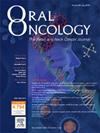Oncological outcomes of pathological extranodal extension (pENE) in oral squamous cell carcinoma (OSCC): A proposal to refine the current staging
IF 4
2区 医学
Q1 DENTISTRY, ORAL SURGERY & MEDICINE
引用次数: 0
Abstract
Background
Extranodal extension (ENE) is an important prognostic factor in oral squamous cell carcinoma (OSCC), often associated with poor survival outcomes. However, the current nodal (N) staging system may need to be revised to reflect the prognosis. Emerging evidence suggests that the number of positive lymph nodes may offer improved prognostic accuracy. This study evaluates the outcomes of OSCC patients with pathological ENE (pENE) and explores the prognostic significance of absolute positive lymph node count.
Materials and Methods
This retrospective cohort study analyzed 640 OSCC patients with pENE who underwent curative-intent surgery and standard adjuvant therapies between May 2015 and December 2021. Receiver Operating Characteristic (ROC) curve analysis was performed to identify a cutoff for the number of positive lymph nodes predicting overall survival (OS). Survival analyses were conducted using Kaplan-Meier curves, and Cox proportional hazards regression was used to identify independent predictors of OS and disease-free survival (DFS).
Results
In the entire cohort, the median DFS was 16 months (95 % CI: 12–19), and the mean OS was 57 months (95 % CI: 52–62). ROC analysis identified four positive lymph nodes as the optimal cutoff for predicting OS (AUC = 0.562, p = 0.01), with a sensitivity of 46.3 % and specificity of 65.2 %. Patients with > 4 positive lymph nodes had significantly poorer outcomes compared to those with ≤ 4 nodes: median DFS was 9 months vs. 21 months (p < 0.001), and mean OS was 26 months vs. 61 months (p < 0.001). Multivariate Cox regression confirmed the number of positive lymph nodes as an independent predictor for OS (HR = 0.6, p < 0.001) and DFS (HR = 0.5, p < 0.001).
Conclusion
Patients with pENE and > four positive lymph nodes have significantly worse survival outcomes despite standard adjuvant therapies. This highlights the need for improved risk stratification in the current nodal staging system. These findings suggest incorporating lymph node burden into staging frameworks could improve prognostic accuracy.
求助全文
约1分钟内获得全文
求助全文
来源期刊

Oral oncology
医学-牙科与口腔外科
CiteScore
8.70
自引率
10.40%
发文量
505
审稿时长
20 days
期刊介绍:
Oral Oncology is an international interdisciplinary journal which publishes high quality original research, clinical trials and review articles, editorials, and commentaries relating to the etiopathogenesis, epidemiology, prevention, clinical features, diagnosis, treatment and management of patients with neoplasms in the head and neck.
Oral Oncology is of interest to head and neck surgeons, radiation and medical oncologists, maxillo-facial surgeons, oto-rhino-laryngologists, plastic surgeons, pathologists, scientists, oral medical specialists, special care dentists, dental care professionals, general dental practitioners, public health physicians, palliative care physicians, nurses, radiologists, radiographers, dieticians, occupational therapists, speech and language therapists, nutritionists, clinical and health psychologists and counselors, professionals in end of life care, as well as others interested in these fields.
 求助内容:
求助内容: 应助结果提醒方式:
应助结果提醒方式:


